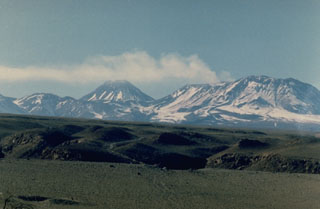Report on Lascar (Chile) — January 1991
Bulletin of the Global Volcanism Network, vol. 16, no. 1 (January 1991)
Managing Editor: Lindsay McClelland.
Lascar (Chile) Vapor plumes extend 60 km
Please cite this report as:
Global Volcanism Program, 1991. Report on Lascar (Chile) (McClelland, L., ed.). Bulletin of the Global Volcanism Network, 16:1. Smithsonian Institution. https://doi.org/10.5479/si.GVP.BGVN199101-355100
Lascar
Chile
23.37°S, 67.73°W; summit elev. 5592 m
All times are local (unless otherwise noted)
"After the last small eruptive episode observed on 6 April 1990 and the continuing collapse of the summit dome formed in 1989 (15:3-4), Lascar has returned to its normal fumarolic activity with the generation of mainly white plumes that rise a few hundred meters above the rim of the active crater. During field observation on 24 November 1990, irregular, dominantly steam emissions were continuously released. In the morning, eruption columns rose to 1,500 m above the cone with cauliflower-shaped tops shifted slightly northward by near-summit winds. Gentle summer winds allowed the development of large plumes that extended N-NW for more than 60 km."
Geological Summary. Láscar is the most active volcano of the northern Chilean Andes. The andesitic-to-dacitic stratovolcano contains six overlapping summit craters. Prominent lava flows descend its NW flanks. An older, higher stratovolcano 5 km E, Volcán Aguas Calientes, displays a well-developed summit crater and a probable Holocene lava flow near its summit (de Silva and Francis, 1991). Láscar consists of two major edifices; activity began at the eastern volcano and then shifted to the western cone. The largest eruption took place about 26,500 years ago, and following the eruption of the Tumbres scoria flow about 9000 years ago, activity shifted back to the eastern edifice, where three overlapping craters were formed. Frequent small-to-moderate explosive eruptions have been recorded since the mid-19th century, along with periodic larger eruptions that produced ashfall hundreds of kilometers away. The largest historical eruption took place in 1993, producing pyroclastic flows to 8.5 km NW of the summit and ashfall in Buenos Aires.
Information Contacts: M. Gardeweg, SERNAGEOMIN, Santiago.

